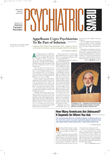Do serotonin abnormalities in the brain underlie suicidal thoughts and behavior? Postmortem evidence from the brains of suicide completers indicates yes. So has cerebrospinal fluid evidence from suicide attempters. And now evidence from the brains of a handful of suicide attempters indicates yes as well.
Kees van Heeringen, M.D., Ph.D., chair of psychiatry at the University Hospital Gent in Belgium, and his coworkers have found that serotonin receptors in the prefrontal cortex of nine suicide attempters did not bind as well as did serotonin receptors in the prefrontal cortex of 13 control subjects. They reported their finding in the April Journal of Affective Disorders.
“These results compliment our findings,” Maria Oquendo, M.D., an associate professor of clinical psychiatry at Columbia University, told Psychiatric News. In the January Archives of General Psychiatry, Oquendo and her team reported that they had found less serotonergic response to a chemical challenge in the prefrontal cortexes of 16 very suicidal depressed subjects than in the prefrontal cortexes of nine less suicidal depressed subjects.
Still another strength of the study, Oquendo pointed out, is that the researchers focused on those serotonin receptors that have been found to be involved in suicide completion—the 5-HT2a receptors. The study also links poor 5-HT2a binding with hopelessness—a well-documented risk factor for suicide.
The suicidal subjects whom van Heeringen and his colleagues selected for their study were persons who had been admitted to the University Hospital Gent Department of Psychiatry following a suicide attempt. Seven were male, two female. For at least six months before the study, all were free of psychotropic drugs, except for benzodiazepines, barbiturates, or anti-epileptic drugs that were ingested during the suicide attempt. None were substance abusers. Control subjects consisted of seven males and six females who were recruited from the hospital staff and screened for personal and familial psychiatric histories as well as medical histories. None used psychotropic medications or abused substances.
The suicidal subjects were assigned a psychiatric diagnosis according to DSM-IV criteria. Four were diagnosed with major depressive disorder, two with narcissistic personality disorder, one with borderline personality disorder, one with dependent personality disorder, and one with brief psychotic disorder. Then both suicidal subjects and control subjects were assessed for personality characteristics using a Dutch version of Cloninger’s 240-item Temperament and Character Inventory and for hopelessness according to Beck’s Hopelessness Scale. After that, a radioactively labeled chemical that binds selectively to 5-HT2a receptors and brain imaging were used to visualize 5-HT2a receptor binding in all the subjects’ frontal cortexes.
The researchers then compared serotonin receptor binding in the suicide attempters with that in the controls. They found that the suicide attempters had a significantly lower binding potential of 5-HT2a receptors in the prefrontal cortex than had the control subjects, especially in the dorsolateral area of the prefrontal cortex, which is involved in anticipation and planning.
The investigators then looked to see whether they could identify any personality traits that characterized the suicide attempters compared with the controls. The suicidal subjects scored significantly higher on harm avoidance and hopelessness and significantly lower on self-directedness and cooperativeness than had the controls.
Finally, the scientists attempted to see whether they could make any statistically significant connections between the low serotonin-binding potential in the prefrontal cortexes of the suicidal subjects and particular personality characteristics that the subjects possessed. A significant link was found between harm avoidance and binding potential and also between hopelessness and binding potential.
Thus, “lower central serotonergic function, hopelessness, and harm avoidance are interrelated phenomena, which may increase the probability of the occurrence of attempted suicide,” van Heeringen and his team concluded.
The results, van Heeringen told Psychiatric News, also imply that drugs that enhance serotonin activity in the brain might possibly “prevent the occurrence of suicidal behavior through their effect on hopelessness and anxiety regulation.”
In fact, Oquendo and her coworkers are exploring the possible value of the SSRIs, as well as of some other medications, in preventing suicidal behavior (Psychiatric News, October 18, 2002).
The study by van Heeringen and his colleagues was financed by the Fund for Scientific Research–Flanders.
An abstract of the study, “Prefrontal 5-HT2a Receptor Binding Index, Hopelessness, and Personality Characteristics in Attempted Suicide,” can be accessed on the Web at www.sciencedirect.com by clicking on “Browse A-Z of journals,” then “j,” then Journal of Anxiety Disorders. ▪
